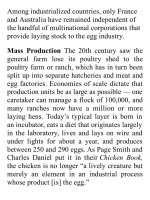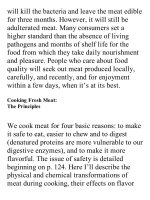On food and cooking the science and lore of the kitchen ( PDFDrive ) 412
Bạn đang xem bản rút gọn của tài liệu. Xem và tải ngay bản đầy đủ của tài liệu tại đây (122.39 KB, 2 trang )
briefhigh-temperaturetreatmentto
brownand/orsterilizethesurfaces.
Compensateforuneventhicknessby
cuttingslashesinthethickareasevery1–
2cm.Thiseffectivelydividesthethick
areasintosmallerportionsandallows
heattopenetratemorerapidly.Another
strategyforrelativelylargeportionsisto
coverthinareaslooselywithaluminum
foil,whichblocksradiantheatandslows
theircooking.
Checkthefishearlyandoftenfor
doneness.Simpleformulas—10
minutestotheinchisapopularone—
andpastexperiencecangetyouinthe
vicinityofthecorrecttime,butthere’s
nosubstituteforcheckingtheparticular
piece.Thiscanbedonebymeasuringthe
internaltemperaturewithareliable
thermometer,peeringintoasmall
incisiontoseewhethertheinteriorisstill
translucentoralreadyopaque,pullingon
asmallbonetoseewhetherthe
connectivetissuehasdissolvedenoughto
releaseit,orpushingasmallskeweror
toothpickintothefleshtoseewhetherit
encountersresistancefromcoagulated
musclefibers.
Why Careful Cooking Sometimes Makes
Fish Mushy Slow and gentle heating has an
important place in meat cooking, and some
fish — Atlantic salmon, for example — can
develop an almost custard-like texture if
heatedgentlyto120ºF/50ºC.Infishcooking,
however, slow cooking can sometimes
produceanunpleasant,mushytexture.Thisis
caused by protein-digesting enzymes in the
muscle cells of active fish and shellfish that
help convert muscle mass into energy (p.
189). Some of these enzymes become
increasingly active as the temperature rises
during cooking, until they’re inactivated at
130–140ºF/55–60ºC. Mush-prone fish (see









